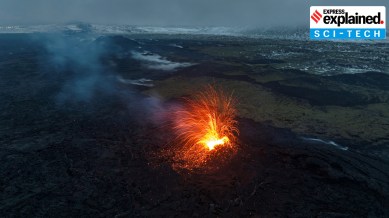Iceland volcano eruption: What are volcanoes and why is the island so volcanically active?
Iceland is one of the most volcanically active regions on the planet. It witnesses an eruption every four to five years. However, since 2021, the frequency has spiked to almost one eruption per year.

Lava flows from a volcano in Iceland were slowing down on Wednesday (December 20), although new vents could open at short notice, according to the Icelandic Meteorological Office. The volcano, which is known as Fagradalsfjall and located on the Reykjanes peninsula in southwest Iceland, erupted on Monday (December 18) after weeks of intense earthquakes and tremors.
In the first two hours of the eruption, hundreds of cubic metres of lava per second flowed out of the volcano. The authorities anticipated the eruption due to the seismic activity and evacuated nearly 4,000 people last month from Grindavik, a fishing town threatened by the lava flow. So far, there have been no reports of injury but some houses have been damaged, according to the BBC.
monthly limit of free stories.
with an Express account.
This is the third time that the Fagradalsfjall volcano has erupted in the past two years. It had been dormant for over 6,000 years but became active in March 2021. Notably, Iceland is one of the most volcanically active regions on the planet. It witnesses an eruption every four to five years. However, since 2021 the frequency has spiked to almost one eruption per year.
Here is a look at what volcanoes are, their different types, and why Iceland is so volcanically active.
What are volcanoes?
According to the US Geological Survey: “Volcanoes are openings, or vents where lava, tephra (small rocks), and steam erupt onto the Earth’s surface.”
Volcanoes can be on land and in the ocean. They are formed when material significantly hotter than its surroundings is erupted onto the surface of the Earth. The material could be liquid rock (known as “magma”, when it’s underground and “lava” when it breaks through the surface), ash, and/or gases.
The rise of magma can take place in three different ways, according to NASA. First, when tectonic plates — massive, irregularly shaped slabs of solid rock that carry both continents and oceans and are constantly in motion — move away from each other. “The magma rises up to fill in the space. When this happens underwater volcanoes can form,” it added.
Second, when the plates move towards each other. “When this happens, part of Earth’s crust can be forced deep into its interior. The high heat and pressure cause the crust to melt and rise as magma,” NASA said.
Third is how magma rises at the hotspots — hot areas inside of the Earth, where magma gets heated up. As magma gets warmer, it becomes less dense, leading to its rise.
What are the different kinds of volcanoes?
According to the British Geological Survey, the type of volcano depends on the viscosity of the magma, the amount of gas in the magma, the composition of the magma, and the way the magma reaches the surface.
There are two broad types of volcanoes: a stratovolcano and a shield volcano. Stratovolcanoes have steep sides and are more cone-shaped than shield volcanoes have a low profile and resemble a shield lying on the ground.
There are also a host of different “volcanic features that can form from erupted magma (such as cinder cones or lava domes) as well as processes that shape volcanoes,” the government agency added.
Why is Iceland so volcanically active?
There are two reasons for this. One, Iceland sits on the Mid-Atlantic Ridge (part of the longest mountain range in the world) in the North Atlantic Ocean, where the Eurasian and North American plates are moving apart a few centimetres every year.
The UK’s Meteorological Office said: “This produces volcanic rift zones, regions where the Earth’s crust is being pulled apart and fractured, and here molten rock, or magma, rises up, and some reaches the surface and erupts as lava and/or ash.”
Two, the island sits over a hot zone (or hotspot, as mentioned before), which leads to enhanced volcanic activity in the region.